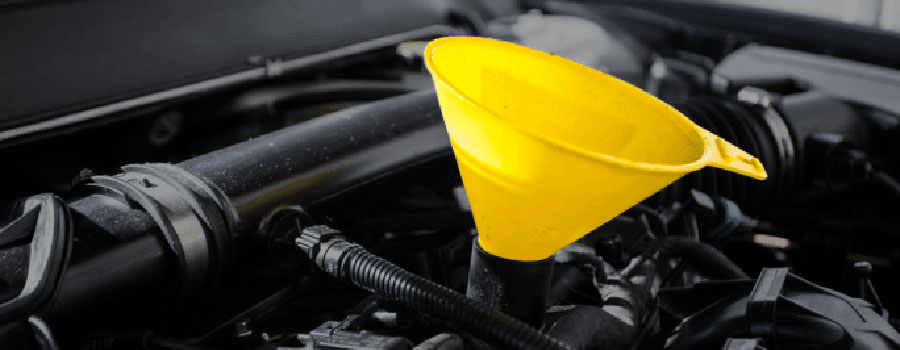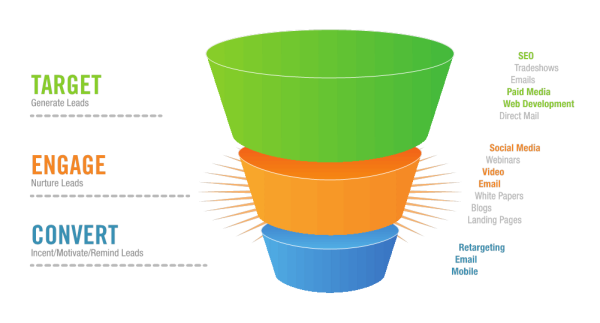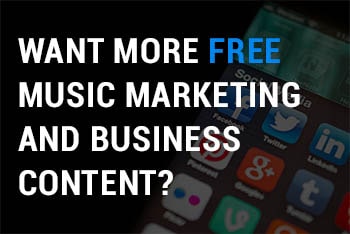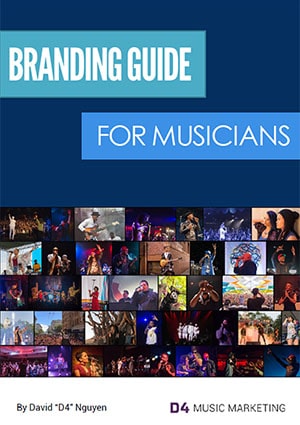
If you want to grow your fan base effectively, you need to think about funnels. Of course, I am not talking about an actual physical funnel, but metaphorically speaking.
In business, a sales funnel (or similarly a buyer’s journey) is a process that consists of different stages or touchpoints that potential customers pass through as they become more interested in your products and services until they reach the desired action or sales transaction at the end.
As artists and musicians, your customers (or fans) go through different stages as well to take the ideal action at the end of the funnel, which is typically to buy your music and pay to see your show. However, instead of sales funnels, I like to think of it as a fan or relationship funnel when talking about music.
The purpose of this blog is to introduce the concept of the fan funnel and explain how it can make your marketing efforts more efficient and effective for building a fan base as an artist.
Why are Fan Funnels Important for Artists?
If you want to make a living off music, you need to treat it as a business. Part of the business is choosing the best music business model for you and knowing how to build a fan base within that model to market to them effectively.
The fan funnel is the process that you want your typical fans to take as they build trust with you, and develop a deeper connection to your brand. The goal is to get to them through the bottom of the funnel and make a transaction.
The problem is fans don’t just empty out their pockets for artists that easily anymore, especially when you consider how record sales have been declining for over a decade.
Before the internet, your big source for music discovery was the TV or radio. If you liked a song or an artist, you went out and bought the single or the album. There was no social media or place where you could really interact with artists directly.
Now that the internet has provided so much easy accessibility to everything, the fan funnel and fan journey has become a longer process before a transaction takes place. There are just so many more options and distractions that it makes building a fan base more challenging. This means you will need to put more work into the fan relationship before they will support you financially.
I think it’s important for musicians to be aware of this process and visualize the various stages that a person goes through to become a fan. It will help you prioritize and make better business decisions.
What Does a Fan Funnel Look Like?
The optimal fan funnel will usually stay relatively static for each artist depending on their goals, strategy and audience. In reality, the fan journey (the process that each fan actually takes to become a paying fan) will always vary in some way for each artist.
Establish a Goal
First, you need to determine what your main goal is and the path that potential fans will need to take to reach that goal. This path consists of stages or touchpoints that contain their own micro-goals that lead fans to the main goal. You can look at these individual stages as mini funnels within a bigger funnel depending on which path they take. So each objective you meet, means you are that much closer to accomplishing your overarching goal.

Although it’s not labeled, think of all the space outside of the funnel as the general population. However, you cannot technically reach everyone, nor should you want to as it defeats the purpose of “marketing,” so you need to begin at the first stage of the funnel.
Target (or Awareness) Stage
At the very top of the funnel, you have the Target (or Awareness) stage that represents the various channels in which your target market can become aware of you and potentially be interested in your music. This part of the funnel is focused on attracting or targeting a specific market or demographic of people who may be interested in the products or content you have to offer as a musician. People can be funneled into this stage from different sources:
- Someone else’s social media post
- Word of mouth like a friend recommendation
- Your Facebook or Instagram Ads
- Doing gigs for new people
- Playlists or music streaming services
- Coming across your content (like a video on YouTube)
- Depending on how fans enter into your fan funnel, their specific path and the touchpoints they encounter will vary, but it will still follow the same general flow as shown in the graphic.
I mentioned before that each stage in the funnel can have its own micro-goals. An example of a micro goal in this stage could be a social media follow so you will want to provide the appropriate content or offer to get initially into your funnel. For example, one way to get people into the Awareness stage is by creating videos of you covering songs by artists that potential new fans are searching for with a similar sound to your music. In the video, you can offer the cover song as a free download (just be wary of copyright laws regarding cover songs). From here, you can go about it in 2 general ways:
1) Basic tactic: Require them to follow you on a specific social media platform in exchange for the download on a service like Show.co, Toneden or Unlock.fm.
2) More advanced: Provide the download link to the song for free on your website with no friction (meaning you’re not making them give you something in exchange). However, you need to have a Facebook pixel on your website so that you can tag them so you can push Facebook ads to them later. This is definitely a more advanced tactic that requires a larger following and a budget to be effective, but I just want to put it out there as an example of what is possible. From here, you can push ads to follow you on Facebook or follow up with another free download like an EP in exchange for an email address.
Engage (or Nurture) Stage
In the middle section of the funnel, you have your Engage (or Nurture) stage. Most fans will stay here the majority of the time. This stage is like the hangout spot where you grow your relationship with your fans by providing them content and music. In turn, they engage with you and show interest in what you do. As a result, you build trust and support.
Read more about engaging and nurturing fans in this blog.
An example of a micro goal here would be to get an email address. If fans are enjoying your music and social media content, they may want to get more content from you directly, so they will readily give you their email. To entice them, you can offer something like a free download in exchange for an email address, which ties into the example above. For more ideas on collecting emails, check out 5 Most Effective Ways Music Artists Can Build An Email List.
Convert (or Action) Stage
At the bottom of the funnel, you have the Convert (or Action) stage where your goal is to have fans make some kind of sales transaction. This can be to buy your music, merch or ticket to a show. Once this transaction has taken place, they end up back in the Engage / Nurture stage, despite the fact that’s not how actual funnels work. However, once they reach through this stage, the process starts over again.
As I alluded to earlier, people who spontaneously come across your music are less likely to jump into the transaction process, especially with how music streaming is dominating how we consume music now. So you can’t be in the mindset of churning out sales transactions. If you are, here’s why you need to stop thinking transactionally.
How to Visualize Your Fan Funnel (Examples of a Fan Journey)
As mentioned earlier, not all fans will have the same fan journey and not everyone will enter your fan funnel the same way. What your goals are and where you are in your career will help determine the right strategy for you to grow your fan base.
Here’s an example of what a general fan journey may look like and how it resembles the stages of a fan funnel:
- A friend tells you about this artist they really like.
- You search their name on Google.
- You find their YouTube channel or SoundCloud account and listen to some songs.
- You like what you hear so you go to their website to learn more about them.
- You notice they are on Instagram and Spotify, two platforms you use the most, so you follow them.
- Over time, you start to listen to more of their songs on Spotify. You occasionally see some of their posts on social media and engage with them.
- Down the line, they have a new EP they are offering for free in exchange for an email address. You like their music so you do it.
- Months later, you receive an email that they are going on tour in your city.
- You go to their show and it was great. As you walk out, you notice some merch so you buy a shirt and a CD.
From this example, you should be able to visualize what this fan funnel would look like and have a basic understanding of the processes that need to be in place to make this funnel work.
Imagine if you didn’t have a website or have your music on Spotify. Or what if you didn’t have a process to capture emails or even a mailing list? You may have potential fans slipping through the cracks and not even realize it.
Here’s a slight variation of the fan journey that comes from a different source. As short as it is, it is entirely possible.
- You check out the opener at the show of your favorite artist.
- You listen to their music and like what you hear.
- You notice they are on Instagram and Spotify, two platforms you use the most, so you follow them.
- At the end of their set, they mention that you can download their latest EP for free by signing up for their mailing list. You sign up at the merch booth after.
- Over time, you engage with them on social media.
- Months later, you receive an email that they are going on tour in your city so you go.
Lastly, here’s a totally different fan journey that comes from Facebook or Instagram Ads.
- You scroll through your Instagram feed before you sleep.
- A music video playing in an ad from an artist you’ve never heard of catches your attention.
- You click on their profile to learn more about them.
- You like what you see from what they’ve posted so you follow the artist on Instagram.
- Over a span of a year, you randomly engage with them on social media.
- One day, you see an Instagram ad from that artist announcing a new album with a special offer.
- You go to their website to buy the album and you find the album on Spotify to listen.
The main point is you need to have your marketing systems in place. Not only to get people into the top of your funnel, but also to facilitate the nurturing process to get them to take action. The fun funnel is what helps you visualize and complete the process.
Conclusion
By segmenting fans into different stages of a funnel, you’ll know what type of content to create depending on what specific goal you may have at the time. For example, if you need to raise brand awareness and get people into the top of the funnel, you’ll want to create content like covers to get the attention of people who don’t know who you are.
Or maybe you have a new album coming out soon. You want to build up your email list because you know reaching fans directly through email is more effective than social media. In this case, you would set up a process where you promote your best single on the new album as a free download on your social media channels in exchange for their email address.
The concept of funnels helps you visualize the process your ideal fans would go through and will help you hone your marketing strategy. However, in reality, this process is not always going to be linear as there are a number of different fan journeys and channels people can travel through. However, the better you understand the buyer’s journey, you will be able to prioritize your marketing efforts and make better business decisions.
The 3 big takeaways for this blog are:
- Being aware of the fan funnel that works for you based on own situation. This way, you can set up the necessary processes in place to nurture fans into loyal, paying fans.
- The fan funnel in the age of the internet is much longer than it used to be. This means that it takes more time to nurture fans to financially support you, especially when people are no longer buying music and prefer to stream it for free.
- Your job is not done once a fan completes the funnel. It’s an ongoing process for however you want your career to last.








Thanks for the info